>>What gets measured, gets managed.<<
– By: Niklas Goeke –
Interesting theory about time:
The reason each year seems to fly by faster than the last is that as you age,each year represents a smaller portion of your life.
Here’s a visual example:

If you’re 1 year old, one year is your entire life. If you’re 14 years old, one year is only 7% of your life.
And so on.
That means at 42 years old, a year is only 2% of the time you’re alive, and it gets less with every year!
Seems to be true for me, and while I always ponder about the happenings of the last 12 months during those last few days of the year, I thought I’d take those ponderings public this time.
Since my blog is a blog about habits, why not make it a habit review?
Below are 15 good and bad habits I tried to cultivate in 2015, how I did, and a tip to master every single one.
Note: To help you nail all habits, I’m giving away 3 copies of The Power of Habit by Charles Duhigg for my birthday this year.
Habits I tried to cultivate in 2015
Let’s take a look at all the good habits I tried to pick up and turn into actual habits last year.
Set priorities for your day

I had been making a very serious effort to limit my priorities to 1–3 per day since early last year, but only started fully committing to it and tracking it in June.
The way this would look is that a little sticky note on my laptop’s desktop holds 1–3 priorities for my day, which I fill in each evening as I wrap up my day, in order to plan for the next.
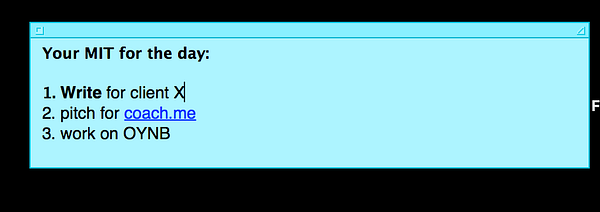
I’ve been doing really well at this, checking in every day, except for one day in December, where I was coming off a bad sickness and really lacking structure for my day.
However, I keep floating around between 1 and 3 priorities per day, and I’d love to settle on one of the two.
But right now, my day to day and the way I earn my money seems to make it necessary for me to sometimes have multiple priorities (and I actually like working on multiple things in one day occasionally), so this is yet to be determined.
Tip: ALWAYS set your priorities the night before, especially if you want to get going fast in the morning. Deciding what’s important in the moment can be hard, especially when you’re already being bombarded by requests.
Wake up by 6:30
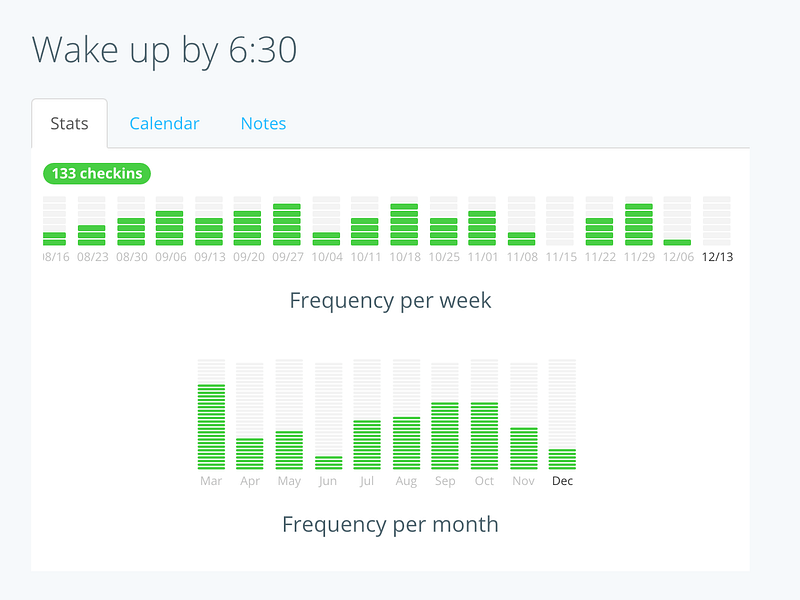
Starting with my Miracle Morning practice I also made a commitment to get up earlier, which has been semi-successful.
I love waking up early, but as of October 2014, I’m not a one-man-army any longer (sorry ladies) and keeping a consistent wake up time as a couple has been tough.
My girlfriend and I live in two different cities, in the beginning of the year it was a long-distance relationship, which often meant late-night video phone calls via Facetime.
Now we’re only 30 minutes apart, but spending one night at her place (at which we cram ourselves into a tiny one-person bed), one night at mine (where we have a bigger bed), plus talking on the phone on days where we’re not in one place has made it tough to keep a consistent bedtime, which is the number one determining factor of a consistent wake up time.
Long story short: I need to get better at this.
I’m considering kicking it up a notch and trying to wake up at 5 am, which might sound counterintuitive, but since I’m a Sudden Sammie, big changes sometimes come easier to me than small ones.
Tip: Don’t start improving your mornings before your evenings go well. Just like setting priorities, this habit really starts the night before, not the day of.
The Miracle Morning

Practicing the Miracle Morning itself went better, I hardly failed at this. I really like the structure this habit creates and how it sets me up for a successful day ahead.
However, I have been, and still am, experimenting with the elements of silence, affirmations and visualization.
As I go along and tweak this even further I’ll keep you guys posted on the different elements of it and what I found works best for each of them.
Tip: If you think the whole routine is too much, start with only 1 or 2 of the SAVERS and build up as you go along.
Cold Showers
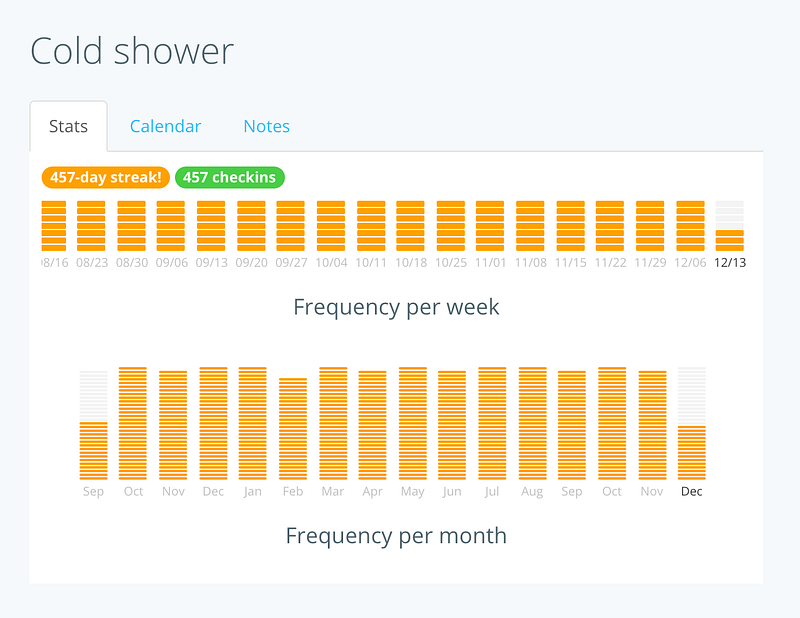
Need I say more? 457 days in a row and counting.
Depending on the day, personal fitness and season I tweak this to be cold-hot-cold for cleaning myself or just a quick cold shower, but I find it still has the same effect every time: I have to step up, turn the knob to cold, and face the fear of cold water.
I’ve written about the combined effects (I noticed 7 of them) of cold showershere.
Tip: A lot of people will tell you to “ease into it” by starting with body parts and then moving up to your chest and head area. This isn’t easy, it’s torture. Go full cold instead and then turn the water to hot after a few seconds. Gives you a relieving feeling instead of more pain.
Reading

As reading is part of the Miracle Morning, it came fairly easy to keep this habit. After I got a deal on StackSocial for 90 days of Blinkist for free, I often read a summary inside the app in the morning.
Some days it was just an article, a chapter in a book, or even a single insight on Blinkist, but doing it is what counts, so I’m good.
I want to continue this as is.
Tip: If you’re really short on time, do two things:
1. Check out my new project, Four Minute Books, where I summarize non-fiction books in an easy format that you can read in 4 minutes or less.
2. Use a book as your calendar. Take a pencil and mark each page with the date of the year, or a number for the day. Thenread one page each dayand cross off the number as you turn the page.
Writing

Just like reading, this already went well in the first half of the year, but really picked up steam in the last 6 months.
I love writing. I think it is my keystone habit for success, and combined with waking up early becomes very powerful.
It’s hard to track it down to the word, but spread among this blog, my posts on Medium, guest posts and client work, I’ve written close to 200,000 words in 2015.
I’m not quite at 1,000 words per day yet, but want to get there in 2016.
Tip: Set a ridiculously small amount when starting out, like 100 words. Anyone can type 5 sentences per day, make it easy to get started. Once you have 1,000 words after 10 days, you’ll see the power of marginal gains and naturally increase your word count per day.
Exercise
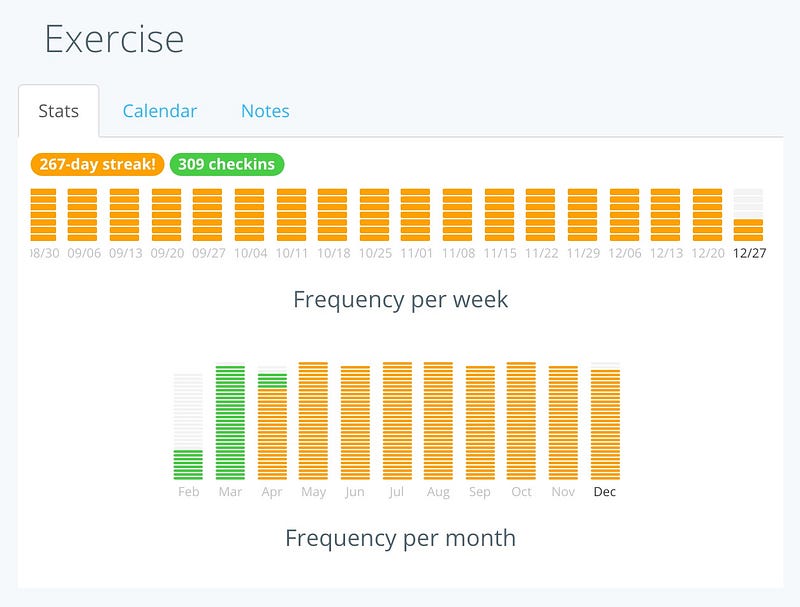
Exercising every day is probably the best habit to pick up for your health, if you want to prevent diseases in the long run.
The reason I exercised every day ever since starting the Miracle Morning is I made it easy enough to do.
It didn’t matter whether I did a set of jumping jacks, took a long walk into the city, or a 10k-run.
You move, you win.
My exercise habit is far from perfect, for example I’d love to swim much more regularly (I couldn’t keep up 3 times a week all year), run more often (I ran around 20 times total, for the first time ever this year), and sit less.
Nevertheless, I think thanks to my minimal exercise habit, I’ve done more than most others, which is why I’m perfectly fine with it.
Tip: Jumping jacks are a great exercise to get the blood flowing in the morning. They don’t hurt, they’re fun and don’t make you break an incredible sweat. Just enough to boot your system after waking up.
Don’t check email before 11 AM

Soon after starting the Miracle Morning, I thought I wanted to use my time in the morning as productively as possible.
When I looked at what got most in the way the answer was clear: email.
Imagine waking up, grabbing your phone, and checking your email.
Ugh.
Your brain goes haywire.
You instantly start to worry about all those requests, answers you have to write and feedback you got, positive or negative.
Plus, you’re likely to waste tons of time reading your emails and thinking about them, but never actually answering them.
The reason I haven’t checked my inbox before 11 am every day since April 28th, 2015, is because I blocked it.
The plugin I’ll show you moves your email to your inbox only at specified times and hides them before, so you can’t even see them if you tried.
This way you can go into your inbox at the specified times, say 3 times a day, and clear out your inbox in one go, meaning you either answer or postpone all emails. It doesn’t matter which one it is, as long as you make a choice for every single one.
Tip: Install INBOX PAUSE, a the Gmail extension that will give you the biggest productivity boost you’ve had in awhile. This was also the tip I shared when my friend Patrik asked me to share my number one productivity tip for 2016. You can find detailed instructions on how to set it up here.
Work 4 hours
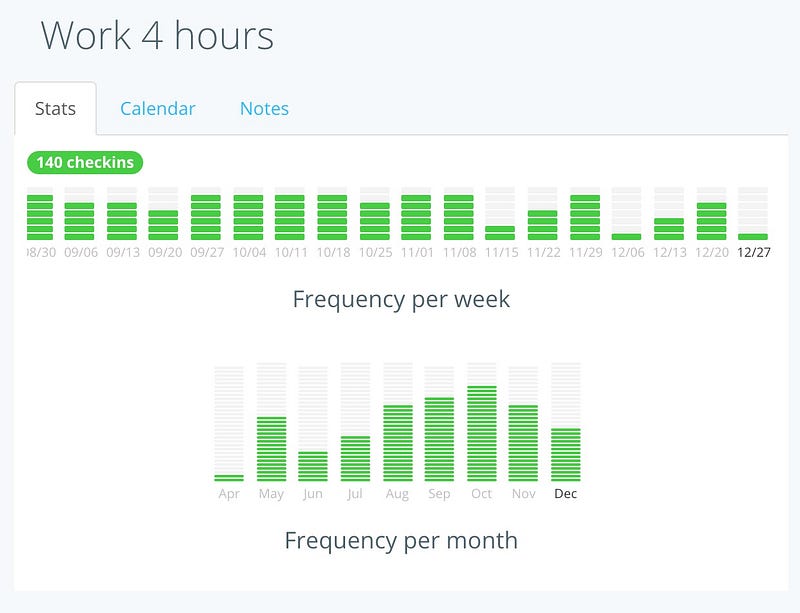
Once I started using the Pomodoro technique, I found I became much more efficient. Considering you’ll do around twice as much as someone in their cubicle at work, who’s constantly plagued by interruptions, coffee breaks, and coworker requests, I set a goal of working 4 hours per day.
That’s 4 hours of focused, uninterrupted, single-tasking time.
The Pomodoro technique works best when you rigorously stick to the 25 minutes of work, then a 5 minute break system — but making it stick is the tricky part.
What really helped me is switching to this Pomodoro timer in late November, which tracks your Pomodoros, so you’re motivated to do more of them until you hit your goal.
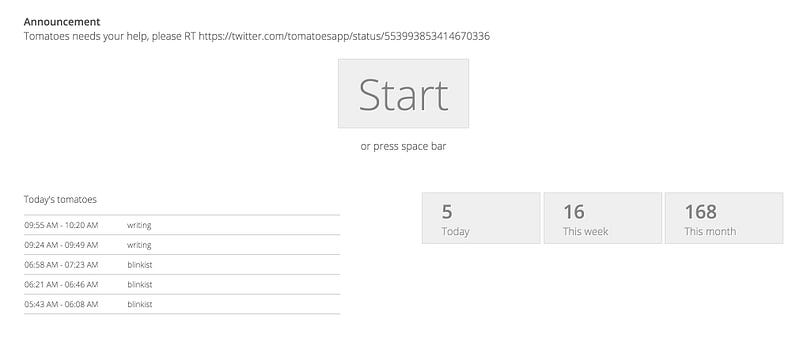
Unfortunately I got sick in December, but am now back to 40 Pomodoro’s per week, which is the most productive workweek ever.
Tip: Eat something during your breaks to refuel you for the next block and keep going longer.
Drink more water
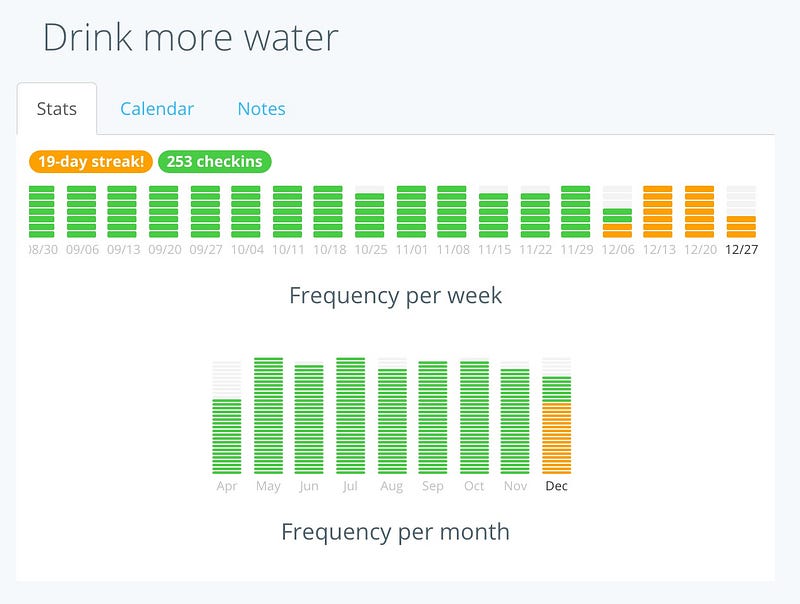
I was coached by my best friend and roommate Paul in this, earlier this year. I have the tendency to not drink a lot while working, and I know drinking 2–3 liters per day is important for your health.
Since it’s an easy win, I decided to give it a go, mostly by committing to drinking a glass of water (300 ml) right upon waking up in the morning.
Thanks to Paul’s initial support, this continues to go well on most days, and I intend to keep it that way.
Tip: Pour your water into a glass, instead of keeping it in a bottle. Unscrewing the lid or popping it open requires additional activation energy and makes it less likely for you to pick it up and actually drink.
Habits I tried to get rid of in 2015
Now it’s time to look at my bad habits, because getting rid of them is just as hard as picking up new good ones.
No alcohol
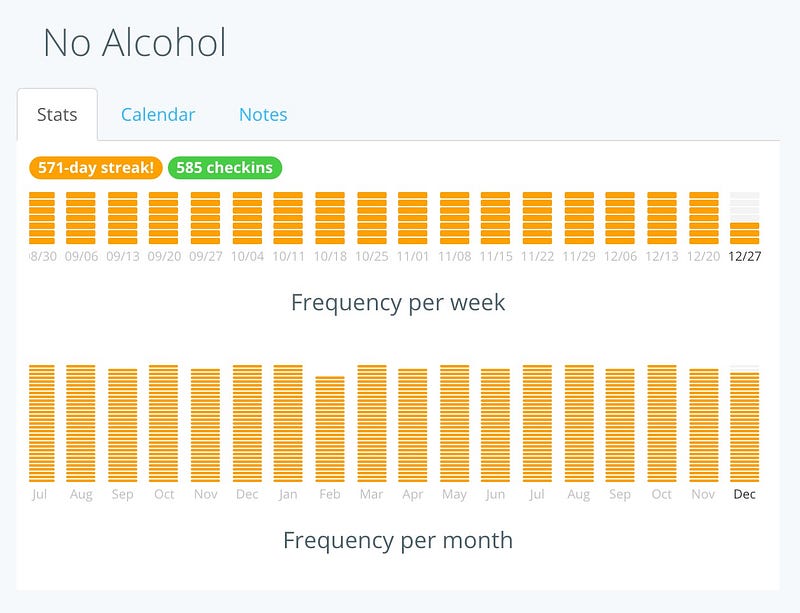
Firing on all cylinders here. I’ve had my last drop of alcohol in June 2014, and I’m not going back.
I’m focused on work, exercise and keeping my few, but high quality relationships that way.
By now I wouldn’t even have time for alcohol, there’s just no space in my life for it.
Tip: Find out whether you’re more likely to stop cold turkey, gradually, or by replacing it first. Knowing yourself is key to making this work.
No caffeine

This was just an experiment. When my girlfriend told me that even though caffeine isn’t as bad as alcohol or cigarettes, it has the same addictive qualities.
If you’ve ever wondered why 1 cup doesn’t do it for you any more after a month, and you increase to 2, then you know what I’m talking about.
I decided to go 100 days without caffeine from one day to the next.
Besides 1 cup of green tea, which my girlfriend poured me without knowing I was doing this, I didn’t have any caffeine for close to 150 days, the last 105 of which were a streak.
Then I gradually added coffee back in, since I really love the ritual, smell, taste, and whole experience of it, but reduced consumption to 1 cup per day, maximum.
As you can see I’m re-doing this experiment right now, we’ll see where it leads me this time.
Tip: When you start out, leave the whole experience the same and just replace your coffee with decaf. Works great and lets you add in herbal tea as a second replacement over time.
Nofap

The big one for guys. Mostly used to get rid of excessive porn consumption, but also a physical challenge, as Nofap ideally suggests you keep your hands out of your pockets entirely.
My story with this habit is very long and complicated, but I originally started the classic 90-day challenge back in February 2013.
I eventually succeeded, even found a girlfriend, it was a horrible fit, we split up 9 months later, and with my following internship at BMW in Munich, I not only fell off the alcohol-wagon, but also off the nofap one.
I took Tim Ferriss’s NOBNOM (no booze, no masturbation) as the perfect reason to get back into it in August 2014, which also led me to becoming a coach in the first place (full details here).
I found my current, wonderful girlfriend one month later, went on a 200+ day streak, but eventually decided to try and find a healthy rhythm for using porn and/or masturbation in August.
Unfortunately, there is no such thing, at least with porn. It’s a zero-sum game, all you do is hurt yourself and support one of the world’s biggest crimes.
My streaks were cut in half after each session, from 40 days to 20 to 10, so I’m re-committing to keeping nofap around long-time.
Tip: Don’t obsess over relapsing after managing to build up a streak of a week or so. Once you’ve gotten into the habit of not resorting to porn instantly, focus on the positive changes you want to make instead. It will take your mind off it, and make sure it’s not constantly in your head, which will only make you relapse more.
No biting nails
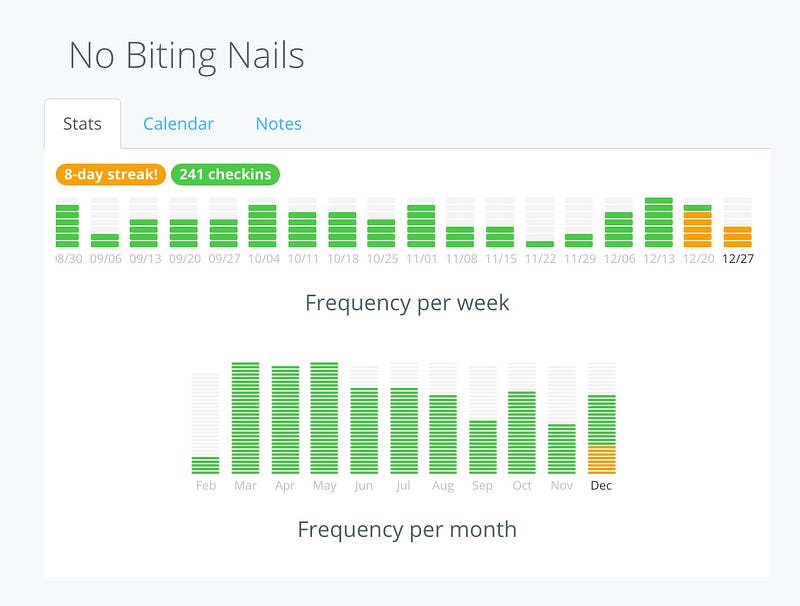
This was the struggle that started my habit journey back in 2012 and early 2013.
I still remember the first day of trying to resist to bite, it was the hardest thing I’d ever done.
After I initially got over it, I never bothered to track it. But this year I felt like it crept up on me again, so I started tracking, and noticed I did bite on occasion.
I’m doing good on this (mostly), but it’s still important for me to keep myself in check here.
Tip: If I had to do it all over again, I would get one of those gels you put on your nails that makes them smell and taste bad. So much easier to get going. Very good strategy in general: Make bad habits harder to do, and good ones easier.
No complaining

Originally I got the idea to stop complaining from Charlie Munger, who said in his USC Law commencement speech that self-pity won’t change anything.
Then I came across the complaint free world challenge, and while I still haven’t gotten one of those wrist bands, I decided to track the habit.
The rule is that I can’t complain just for the sake of complaining. If I point out a flaw or something that isn’t working, I have to follow right up with a possible solution or improvement.
It’s been going well and has helped me focus much more on solving problems, rather than venting about them.
Highly recommended!
Tip: Stop watching the news for a week. You’ll notice it’s all horror stories and complaints. It will not only help you complain less, but also lighten your mood.
Personal goals
In May I set one single personal goal I would work towards: 10,000 email subscribers.
The time frame I set is 18 months. I think 10,000 subscribers will enable me to create a sustainable income that my girlfriend and I can live off and will allow me to do more cool projects and write full time.
9 months in I’m at 2500 subscribers, so I’m about 75% off to be on track, but I expect this to grow faster the further I get.
However, there’s something wrong with this goal in the first place.
The major flaw with it is that I can’t control the number.
For example, in May I’ve been busting my hump with a giveaway, which cost me tons of time and money, but only generated 115 new subscribers.
On the other hand, I had a ton of fun hosting a workshop with my friend Suein December, which brought 160 new people to my email newsletter and took a few hours to host and set up.
I can’t influence how many people sign up on any given day, but I sure can work more on what’s fun and what helps people.
That’s why I’m moving the 10,000 subscriber goal to the background, as a milestone, and focusing on writing more.
I want to write 300,000 words in 2016.
That’s 822 words per day.
I love writing, and since it’s an aspect I control, I think it’s a much better goal than 10,000 subscribers. It should help me focus more on the process and less on the outcome.
Additionally, I’ll do more live workshops and create little side projects, likeFour Minute Books.
I also learned that I hate selling, so in 2016 I want to keep growing, and start creating income based on trust and goodwill using Patreon.
It’s a platform that allows fans to support creators with as little as $1/month, to help them create more, have a sustainable source of income to pay the bills and worry less about rent and food.
If you enjoy my work, I’d love for you to take a look. It takes less than $1,000/month for me to live comfortably, so I hope in 2016 I can make becoming a full-time writer happen.
But I’m going to need your support.
Alright, enough about me.
That’s my habit review — now it’s your turn
What does your habit review look like for 2015?
What went well? What didn’t?
Maybe you’re not even tracking your habits.
If so, it’s time to sign up for coach.me.
And how can you simplify your personal goals?
Do you have your ONE GOAL already? Can you influence it?
I’m excited to see what you’ll create in 2016, and I hope I can help you along the way.
If you don’t know what to do next, struggle, or want to take your habit game to the next level, I’d love to work 1-on-1 with you.
Happy 2016 and stick with it!


